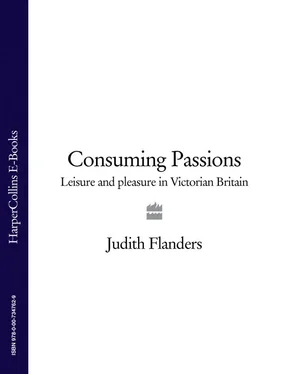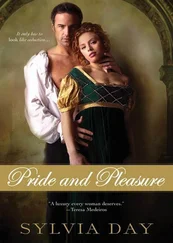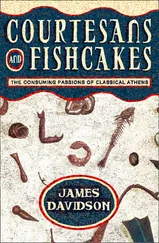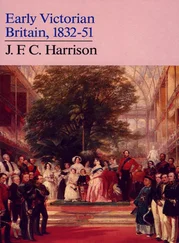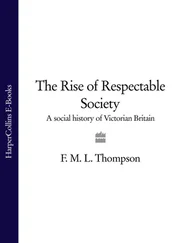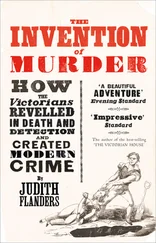It is worth pausing for a moment at the admission charge of 1 s . At this price, and with the less expensive catalogue, the Popular Guide , priced at 2 d. , only the upper levels of the working class—the artisans, the master craftsmen, the clerks (who for the most part would have identified themselves with the lower middle classes)—could possibly have afforded to visit the grounds without financial assistance. For most of the rest of the working classes, having 1 s. to spend on a day’s leisure was unimaginable—and even that price was only for those who lived in walking distance: for the others, transport, accommodation and food would push the day’s expenditure to one or two weeks’ entire earnings. But the mass of workers was so mysterious to their economic superiors that it was as though the 1 s. charge would unleash not just factory operatives and manual labourers, but also the feared ‘navvies’ †who were building the railroads and, even worse, the masses of the unemployed and the unemployable, wild hordes of them sweeping across the plains of Hyde Park. The Times warned that ‘Summer excursion trains will bring the artisans and mechanics of the north in upon London like an inundation.’ 52The Duke of Wellington thought that at least 15,000 men—he meant soldiers—would be needed to keep order. Members of the Exhibition commission met with the directors of the railway companies to arrange that reduced excursion fares would be restricted to benefit-club subscribers and those belonging to working-class self-improvement clubs such as the Mechanics’ Institutes (see below). (However, the agreement did not hold: by February the London and North-Western Railway and the Midland Railway companies had both agreed to supply excursion fares to non-club members, but they took care not to publicize this change—at least at first.) 53This arrangement, while it stood, had the effect of pushing those who had not previously belonged to such a group into one, in order to be able to have access to railway tickets at affordable prices.
In fact the numbers already belonging to some form of club, whether it was a social group, a benefit club, a sick club or an educational or self-improvement group, were enormously high. Friendly societies or benefit clubs were among the most common clubs for workers. Matthew Boulton, a manufacturer, factory-owner and partner with James Watt in the improvement and manufacturing of the early steam engine, was one of the first to see the value to an employer in setting up an insurance club. From the early 1770s his employees received benefits on illness, accident or death, having made contributions as a percentage of their earnings—from 1/ 2 d. a week for those earning 2 s. 6 d. to 4 d. for those earning £1. When they were ill they received payments in inverse proportion to their contributions, so that those earning the least received the most financial assistance—about four-fifths of their weekly wage for those employees with the lowest incomes. But if the illness or incapacity stemmed from ‘drunkenness, debauchery, quarrelling or fighting’, part of the first ten days’ payment was withheld. Boulton as well as his workers benefited from this scheme: by having some financial support in hard times, fewer ill or injured workers ended up being supported ‘on the parish’, which kept the poor rate down, and Boulton’s workers were more likely to stay with him, because if they moved on they would lose the benefit of the contributions they had already paid in. 54
Even without the participation of enlightened employers, mutualsupport clubs were becoming common. The 1793 Friendly Societies Act enabled clubs to raise ‘separate funds for the mutual relief and maintenance of the…members in sickness, old age and infirmity’. 55One estimate suggests that in 1801 there were at the very least 7,200 friendly societies in England and Wales, which together numbered about 648,000 members. In London at least 40 per cent of the working population belonged to a friendly society, while in some new industrial regions the figure was even higher: in Oldham, Lancashire, 50 per cent of all adult males belonged to one of the fifteen societies flourishing there. In Scotland there were nearly 400 friendly societies by 1800. Ireland took longer to develop the concept: in 1800 there were only 7 societies that we know about today, but by 1831 the number had shot up to 281, with half centred in Dublin. 56
Clubs that were not mainly about financial aid were also popular: working men’s libraries, groups to discuss politics or literature, or to buy books. A club in Sunderland met regularly to discuss old English ballads; the members were saving jointly towards the collected volumes of reprints of Early and Middle English texts published by the Early English Text Society. The members consisted of a cork-cutter, two woodcarvers from the docks, a watchmaker, an engine-fitter and ‘a painter of photographs’. * 57
The largest, and most widespread, self-improvement groups were the Mechanics’ Institutes. The first one was set up in 1824 in London, with 1,500 members paying 1 guinea each—clearly, a group of high-earning skilled workers and artisans. By 1850 there were 702 Institutes across the country, but by now they had mostly been taken over by the middle classes: the upper middle classes at the administrative end, and the lower middle classes—clerks and shopworkers—as members. The original expectation had been that these institutes would increase the skills and scientific and technical knowledge of manual labourers by offering access to books and pamphlets in reading rooms, and to continuing education via evening lectures. This would produce a more highly skilled and useful workforce, which would be a great benefit to employers. But fairly swiftly it was discovered that the lectures were too theoretical, and the workers found little practical incentive to attend after a long day’s work. Instead, lectures that gave some form of recreation were preferred, and were much better attended. In its initial period of worker education, from 1835 to 1842, the Manchester Athenaeum held 352 lectures, of which 173 were on the ‘physical and mental sciences’; in 1842—9, out of 394 lectures, science featured in only 81. Nationally, of 1,000 lectures held at 42 institutions in 1851, only 340 were on science, while 572 were classed as literature—although literature here had a fairly broad definition, essentially meaning anything that was not science or music. Included in the list of literature lectures were topics such as ‘the funeral rites of various nations, the habits and customs of the Eskimos, the life, death and burial of Mary, Queen of Scots, the games of Greece, the theosophy of India, the sons of Noah, and…“Are the Inhabitants of Persia, India, and China of Japhetic or Shemitic [ sic ] Origin?”’ There were also twenty-three lectures on Shakespeare, and over the next years many lectures gradually turned into readings from favourite authors, and sometimes simply readings of plays, which was a way of getting around the general disapproval of the theatre by many Dissenters and some Anglicans (see pp. 274—5). 58
The Institutes began to hold exhibitions and social events more generally. The earliest exhibitions, held by the Manchester Mechanics’ Institute from 1837, were in the mould of the lectures on science and technical innovation—exhibitions of ‘machinery, industrial products, scientific apparatus and works of art’. 59Over the next five years, Manchester held four exhibitions, and drew over 200,000 visitors in total. 60From 1838 to 1840 the various Institutes held at least fifty exhibitions across the country. But almost immediately the emphasis altered, exactly as it had with the lectures. By 1846 the Manchester Institute was showing more than machinery, with exhibitions of paintings by Turner, Benjamin West, Landseer and Charles Eastlake. The urge for entertainment rather than education was nationwide: in 1842 the Institute in York saw working-class membership increase as excursions and social events were added to the calendar; by 1844 the Huddersfield members expected a gala, excursions, exhibitions and tea parties. Most of the other groups had moved in a similar direction, with a general leaning towards culture and recreation. And recreation included travel.
Читать дальше
